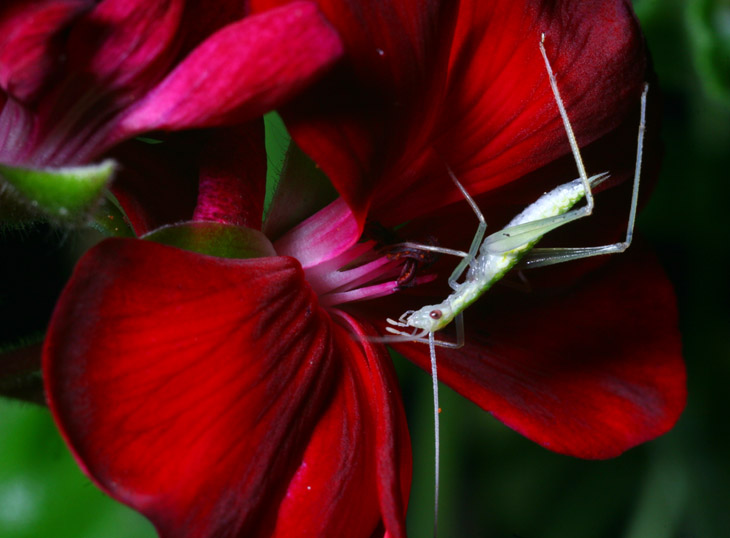
A very recent Monday color image this time, taken just a few days ago when a narrow-winged tree cricket nymph (Oecanthus niveus) posed at night on a geranium blossom. Some mist or dew would have been nice, but it wasn’t happening that night.
Happy birthday Boogs!
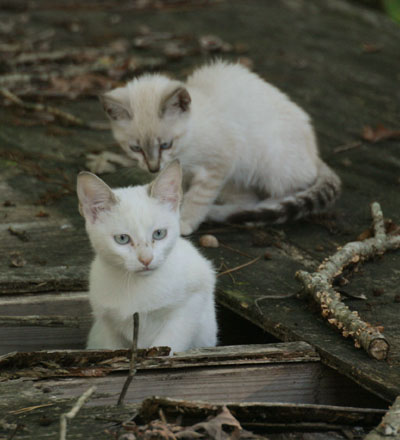 Four years ago today, the Boogs were born. More or less, anyway. When they showed up at the house, it was Labor Day weekend and they were roughly eight weeks old, so we picked a date that was easy to remember.
Four years ago today, the Boogs were born. More or less, anyway. When they showed up at the house, it was Labor Day weekend and they were roughly eight weeks old, so we picked a date that was easy to remember.
The most notable thing about them is the color change they underwent, which you’ll see clearly in a moment when you compare this image, taken while they were still semi-feral and had not yet been in the house, with the recent photos below. But it’s also been interesting to watch their personalities develop, including the faintly obsessive behavior of both.
Little Girl (otherwise known as Zoe) is the tiger-striped one, at the back in this photo, the last to be tamed down – of the four that originally showed up abandoned at the house, she took much longer than the others. But largely because I was the one that forced her to sit still and endure some pleasant attention, she became “my” cat. She’s cool with everyone, but she has several behaviors only displayed around me, including the idea that if I crash for an afternoon nap, I must make a tent of the bedsheets so she can stretch out alongside. If The Girlfriend and I are both napping and we make space in between, this is not acceptable. She has also decided that, when I’m working at the computer late at night, there are specific times for attention. Not to mention the insufferable offense of being locked out of the bathroom when I’m in there…
Kaylee is the randomly-colored one though she appears pure white in the first photo, and while a Siamese-mix like Little Girl, the exact ancestry is muddled but surely eclectic. She became The Girlfriend’s cat, and as the time draws near, she sits impatiently at the window watching for The Girlfriend to come home, becoming a little spastic and racing around excitedly when it occurs, trying to trip people. This is an extension of the ‘keepaway’ game she played when she first came into the house, purposefully darting past people when they reached down to give her attention, then returning to dart past again, a game she still occasionally plays. She is also notoriously bad about eye contact, and will look fractionally off to one side instead of directly – on occasion she meets my gaze fully but looks away again immediately.

Here they are just a few days ago, in an image purposefully taken for the post – you can see the string that coerced them into posing, since they don’t really take direction well. Little Girl is the one reclining. Clearly, their colors wandered a bit from that as kittens. Kaylee, by the way, is obsessive about string, especially if it’s dangled from the upstairs balcony, and if she has been overstimulated with it (The Girlfriend’s Younger Sprog is usually the culprit,) will need a few days to come down before she’ll stop sitting alongside the string and crying forlornly for anyone to animate it.
 This pic is from March, not showing off their colors as well but you can at least see their blue eyes – they’re very pleased with the screened porch of the new house. And the top perch is definitely Little Girl’s – it’s as tall as I am and so she can gaze down at me, engaging in swatting matches and occasionally bopping me on top of the head when she gets excited.
This pic is from March, not showing off their colors as well but you can at least see their blue eyes – they’re very pleased with the screened porch of the new house. And the top perch is definitely Little Girl’s – it’s as tall as I am and so she can gaze down at me, engaging in swatting matches and occasionally bopping me on top of the head when she gets excited.
Some time back I discovered, by accident, that they both respond surprisingly well to whistling – I can only guess that the pitch that I achieve resembles their mother’s call. When getting the indoor photo above, the flash was giving me both confirmation and recharge beeps, to which Little Girl kept answering, eventually walking over to see why it was calling her.
They’re not pleased with loud bangs, however, so as all of you out there celebrate their birthday (and I’m surprised at the following that this blog apparently has,) let’s skip the fireworks over it this year, okay?
Peace or piece?
This is an observation that’s been lurking in the back of my mind for some time now, and I finally decided to set it down in detail. It is sure to make quite a few religious people get defensive, but the point is, that’s probably inevitable.
Let’s start with the simple aspect, and I’m going to fall back onto my old favorite, gravity (as well as subtle but terrible puns, it seems.) Do we ever see anyone arguing for the existence, function, or logic of gravity? Can there be found, anywhere, even the faintest vestige of doubt that it exists? It seems ludicrous to even ask those questions, doesn’t it?
Why, then, do so many religious folk get uptight, like, all of the fucking time? How does the absolute assurance not only of a creator, but one that has distinctly outlined exactly what happens to true believers and nonbelievers, result in the widespread anxiety that forms so much of the public face of religion? How does the idea that same-sex couples can receive legal recognition of their partnership foster so much ire? How does teaching evolution in school count as denying someone’s religion? Why should the eradication of “under god” in the pledge of allegiance (a completely irrelevant ritual to 99.9979% of schoolkids) provoke so much backlash? Truth is truth, right? How can omnipotence be threatened in the slightest?
A ridiculous number of online articles that even mention evolution will receive disparaging comments asserting that evolution is anything from a mere theory to an outright lie, and the vast majority of these comments are, not to put too fine a point on it, distinctly petulant and bratty in tone. Provoked? Not hardly – it’s next to impossible to find any article about evolution that even mentions religion, much less makes any claim that it’s disproved by natural selection. But is it an inferred attack anyway? The case could be made, but then again, it could be made for virtually any science article, as well as any article that mentions a religion other than the one the testy commenter follows. Yet even an inferred attack doesn’t justify the type of responses seen so often.
If you’re a public figure that even mentions homosexuality, secularism, atheism, or merely reducing religious privilege, you can expect a storm of messages promising your eternal torture and assuring you of your gross immorality, with the addition of a few threats of direct violence – because, you know, religion has that ‘force for peace’ thing going on. Point out that some law or practice is unconstitutional and you’ll also invite the diatribes produced from spittle-flecked keyboards. And I shouldn’t have to point this out, but this is not from some marginalized and openly-targeted minority faith, but mostly from those ‘good christians’ that not only make up a majority in this country, but enjoy the frequent rump-osculation from every political party as well, not to mention quite a few perks from the bare idea that religion should be respected. In fact, that’s a favorite word among the religious, a hell of a lot of whom somehow believe such a thing only goes one way. And while there certainly are exceptions, people who would never stoop to such juvenile tactics, don’t be looking for them to correct their brethren, or even suggest civil discourse.
I am a great fan of objectivity, though in some cases the attempt to demonstrate it is pointless, and only worthwhile because this entire post will be summarily dismissed otherwise. So, are these comments being made by children? Well, of course they are, duh! Oh, you mean actual adolescents, below legal age or whatever? The evidence doesn’t really support it; the posts often take place in forums where other obviously youthful comments don’t appear, and where topics of teen interest are few. It’s often not hard to distinguish a comment from a youth, and this is not consistently demonstrated. Moreover, adolescents jumping into adult discussions with derisive commentary just isn’t a common practice – though there are mitigating circumstances that we’ll look at shortly. And finally, if the majority of those holding such attitudes were under voting age, then the politicians wouldn’t be pandering to them at all, would they? Not to mention that we all have personal experience with fully-grown people who demonstrate these outlooks, and I can say that with utter confidence.
Is it fear? Well, of course – but very likely something more than that too. Just the possibility of being wrong doesn’t make people get that uptight, that outright nasty – it takes a lot more, the fear of losing something valuable. That something valuable is privilege, the status that is gained from the very idea of religion. It is important for them to be recognized as superior, because of their very choice of religion – otherwise what would be the point? It’s kind of like when big sister is left in charge, and the younger siblings ignore her orders, safe in the knowledge that she cannot wield the authority (and/or the punishments) that the parents can. Impotent rage takes over.
This would mean that faith, in such cases, doesn’t come from logic or moral guidance or even the reassurance that there is a plan of a benevolent overseer, but from insecurity, the desperation for a special status. If this seems doubtful, consider how often religious symbols are openly displayed in the home, on someone’s person, on the car… who needs to know about this? The omniscient god?
Interestingly, the similarities between this and discussions regarding aliens and conspiracies and such are manifest, in fact almost identical: the same blustering schoolyard attitude, the same condescending and insulting approaches, the same name-calling – and even the same old hackneyed sound bites, over and over and over again. That last bit says a lot all on its own, because it’s not like these sound bites haven’t been answered and repudiated, nor is it likely in any way that doing so yet again will have any affect. The appearance of such arguments is a distinct indicator that the user openly ignores any and all contradictions or corrections – they are not in search of what’s right, only what validates them. And when this validation seems weak – when it seems like it’s being ignored or simply doesn’t have any application at all, when their status is worthless – they strike out with open animosity. It does not provide peace of mind in the slightest – but perhaps a piece of their mind to bestow upon others, at least.
This is not to oversimplify anyone’s motivations, which may be complex, but it bears consideration as a distinct factor in light of the responses; sports and politics are capable of fostering the same. The relation to these is probably not coincidental either, since the convincing, demonstrable superiority of either sports teams or political parties is just as ethereal; it’s not a sign of confidence, no matter how one looks at it.
But since so much of religious belief, and indeed so much of many human behaviors, is prompted by what others are doing, we should take a look at this too; it’s giving more credit than is warranted to assume that all such actions come through careful consideration. There remains the distinct possibility – actually the very high probability – that such attitudes are promoted directly by churches, and the threatened, defensive demeanor is what the flock is encouraged to have, by either the passive beliefs of those around them or the active teachings of their church. This fits in remarkably well with the constant repetition of those aforementioned sound bites, which must be coming from somewhere; such consistency is not generally found among other topics.
Which is a very curious line of thought. Does this mean (or to be more accurate, how often does this mean) that churchgoers are actively steered towards insecurity and looming threat rather than, as we are repeatedly assured, the peace of mind that religiosity promotes? Instead of providing answers and confidence, how many churches play mind games with their followers by making them paranoid? The ‘wolf at the door’ tactic has been used for centuries, often enough by political parties trying to create a common, manipulative cause, and this pretty much defines the idea of satan and evil in the first place.
Don’t get me wrong – people don’t need help being insecure, or seeking some pointless, effortless manner of feeling superior because of it. But that just means churches have a common trait that they can exploit, just like they have for centuries when targeting the disadvantaged or sending missionaries around. And we can’t deny the appeal of becoming ‘better’ just by performing some inane ritual, rather than expending some effort towards honest improvement. But isn’t it funny how this superiority somehow fails to instill confidence?
So how does that happen? Is it a program of careful manipulation, the creation of a specific set of circumstances where the chosen folk are under constant threat from the pagan scientists and Teh Gays? Or is it the dissonance of hearing the assurances from the churches of how things ‘must be’ but failing to see any actual evidence of such? Or is it simply an unaddressable insecurity, to be found no matter what? Or any combination of those, or anything else besides? That will be left as an exercise – I know what I’ve seen plenty of evidence of myself, including the specific assignments for teens, without any useful background, to go to science and secular websites to post their diatribes for church credit. But this is by no means an exhaustive and controlled study.
Funny, though, it simply doesn’t work. While condescension is occasionally a wake-up call to someone being arrogant or assumptive, most times it’s simple annoying, almost the exact opposite of convincing. The abject ignorance of most of the arguments is plainly evident to anyone even remotely aware of the fields usually addressed, and the rabidly defensive responses visibly well out of proportion to the ‘threat’ of same-sex marriage or allowing women to drive cars – it’s remarkably easy to look like a loon. And it says an awful lot that these tactics are still being promoted.
Abstract twofer
 I realize I started a pattern with posting abstract images on the last day of March and April, then pathetically let this lapse for May. So, for June we will have two.
I realize I started a pattern with posting abstract images on the last day of March and April, then pathetically let this lapse for May. So, for June we will have two.
Neither of these need explaining, of course, so I will end the text here, and simply let the images speak for themselves. Stop raising your eyebrow skeptically – I have not been kidnapped and replaced with an exact duplicate.

Monday color 21
 One more courtesy of Jim Kramer’s Alaska trip, which I saved for the Monday color post. I’m not even going to try to identify it – the botany is for someone else. Just appreciate the colors and contrast.
One more courtesy of Jim Kramer’s Alaska trip, which I saved for the Monday color post. I’m not even going to try to identify it – the botany is for someone else. Just appreciate the colors and contrast.
Chow’s on!
A couple of posts ago I mentioned coming back with more photos that followed the rains, and will repeat the warning here: this post is not just icky insects, but icky insects doing icky things.
The mantises have been growing at a noticeable rate, even though it varies among the many I can find. The ones on the Japanese maple tree seem to be finding the most food, and in some cases, it’s not hard to tell what it was.
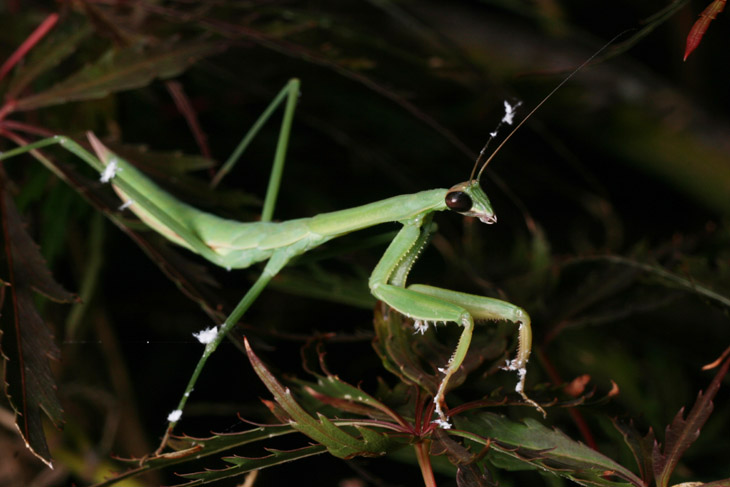
The ‘cotton candy’ visible on the limbs of this one show that its most recent meal was a type of planthopper we’ve seen a lot of this year, the citrus flatid (Metcalfa pruinosa.) They make plant stems look a lot like the mantid’s legs here, only more so. The fluff is the residue they exude from sucking up sap, and while it doesn’t exactly serve as camouflage, being visible from about half a kilometer, it does make it difficult to distinguish the exact location of the planthopper within. But not too difficult for the mantids.

Curiously, it appears that the wings of the species develop before the final, adult stage, which is rare, even if they’re almost certainly not functional as such. For everything else I’ve seen, the wings only appear when they hit the last instar, the reproductive stage.
Both of the above photos were taken at night, so the eyes of both planthoppers and mantis show the color change that occurs then – red for the planthoppers, black for the mantis. As yet, I have not determined what purpose this serves, only assuming that it improves their vision while not giving a hit to their camouflage because it’s too dark to see the contrast.
 When we moved from the old place last year, we left behind a veritable forest of spearmint plants, one of our few regrets in that move – spearmint is, like, the best smelling plant ever. Sure, we brought along several with us to transplant, but none of them took – or so we believed, until one patch started coming back this spring. What you see here is not that patch, however, but one of two new plants we got started that is now thriving. The mantises have previously avoided them but this smaller one has been hunting on one for the past few days, and I spotted it when it was sitting in a provocative position under a spider. Naturally, I decided to wait this one out, making me immediately aware of just how hot the sun was beating down. But in counterpoint, at least the wind hadn’t kicked up the moment I started trying to focus with a macro lens, which happens more often than not. I think they should pay a bunch of macro photographers to live under those wind turbine farms and solve all of our energy problems…
When we moved from the old place last year, we left behind a veritable forest of spearmint plants, one of our few regrets in that move – spearmint is, like, the best smelling plant ever. Sure, we brought along several with us to transplant, but none of them took – or so we believed, until one patch started coming back this spring. What you see here is not that patch, however, but one of two new plants we got started that is now thriving. The mantises have previously avoided them but this smaller one has been hunting on one for the past few days, and I spotted it when it was sitting in a provocative position under a spider. Naturally, I decided to wait this one out, making me immediately aware of just how hot the sun was beating down. But in counterpoint, at least the wind hadn’t kicked up the moment I started trying to focus with a macro lens, which happens more often than not. I think they should pay a bunch of macro photographers to live under those wind turbine farms and solve all of our energy problems…
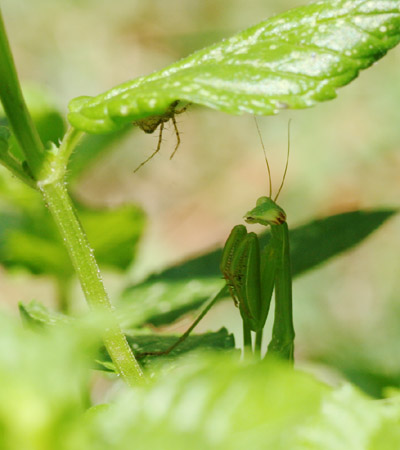 I don’t think it was because of any motion of my own, but abruptly the spider switched to the underside of the leaf (it was the heat I’m sure,) and the mantis stared fixedly at it. Yes, its mouth certainly does seem to be open – you don’t really expect much of any expressions to come from arthropods, but occasionally something appears anyway, strictly by happenstance. At this point the wait, which wasn’t very long at all, seemed perfectly justified, and I watched carefully, knowing that the strike would be too fast for me to time it usefully, but perhaps I could nab the aftermath.
I don’t think it was because of any motion of my own, but abruptly the spider switched to the underside of the leaf (it was the heat I’m sure,) and the mantis stared fixedly at it. Yes, its mouth certainly does seem to be open – you don’t really expect much of any expressions to come from arthropods, but occasionally something appears anyway, strictly by happenstance. At this point the wait, which wasn’t very long at all, seemed perfectly justified, and I watched carefully, knowing that the strike would be too fast for me to time it usefully, but perhaps I could nab the aftermath.
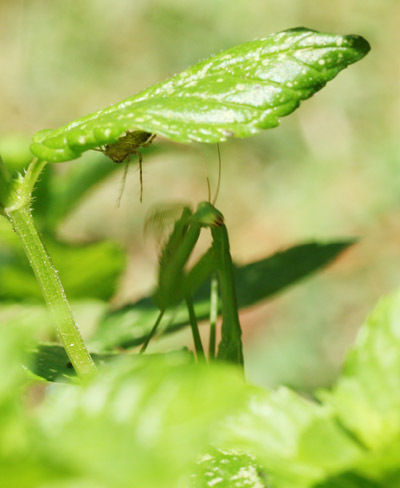 With inordinate luck, I fired off a shot just as the mantis made its move – I had no intention of capturing the crucial moment, I was just grabbing another frame. Working with natural light, the surroundings look a lot better, but the action isn’t stopped by either the shutter speed or flash duration, so there’s some motion blur – which adds to the drama. There’s even a little blur from the spider’s legs, showing that it realized its peril in a fraction of a second.
With inordinate luck, I fired off a shot just as the mantis made its move – I had no intention of capturing the crucial moment, I was just grabbing another frame. Working with natural light, the surroundings look a lot better, but the action isn’t stopped by either the shutter speed or flash duration, so there’s some motion blur – which adds to the drama. There’s even a little blur from the spider’s legs, showing that it realized its peril in a fraction of a second.
But… who won the race? Is it getting all anxiousy up in here? Should I stop now, and continue in another post to let the tension ease a bit?
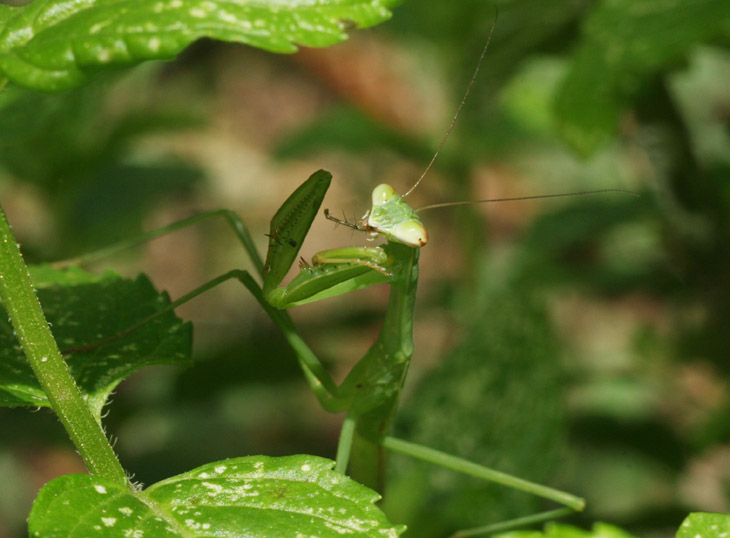
Well, technically, they both won. Or both lost – whatever, the glass is at midpoint. The spider escaped with its life, but not intact; this is why you see so many spiders missing a leg or two (or maybe I’m the only kind of person that notices stuff like that.) The mantis ended up clutching at least two of the spider’s legs, which it then consumed philosophically. Which makes me pause for a second, realizing that we’re probably the only species that does visible displays of chagrin when we miss a goal – cursing and stomping around and flailing our hands pointlessly. Was this something that was beneficial to our survival, a signal to the other hunters that the quarry was still at large or whatever? It certainly found a home in sports, along with the various displays of strutting when points are scored. We’re weird, aren’t we?
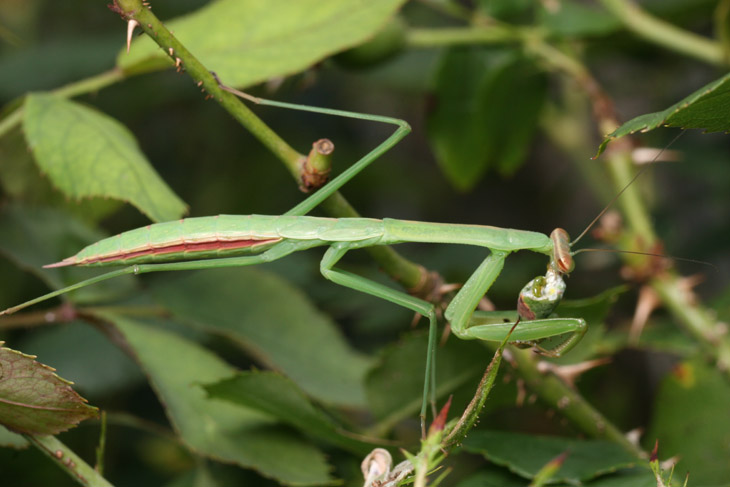
Another mantis was found having moved to the rose bush out front, and was finishing off what I believe to be a katydid. It was down slightly into the depths of the bush rather than right on top, so I was trying a bunch of different angles for the detail shots, and happened upon one that worked for the action at the moment.
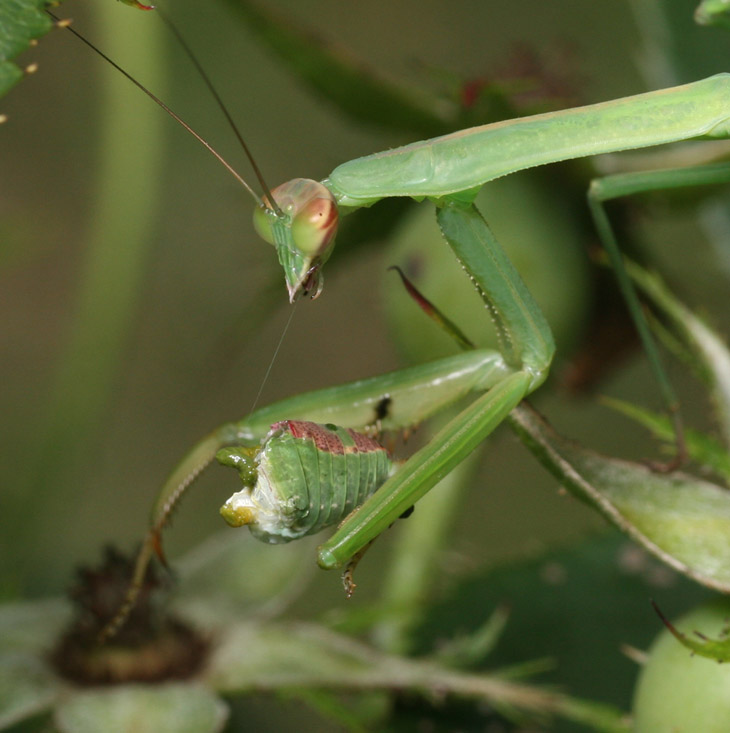
You know that first bite of pizza, when you pull away and the cheese is still gooey and stretches out in a long string? Or maybe a candy bar with caramel. Mmmm, just makes you hungry, doesn’t it?
[I told you it was likely to be disgusting. I just didn’t tell you I was going to make it even worse than the visual aspect.]
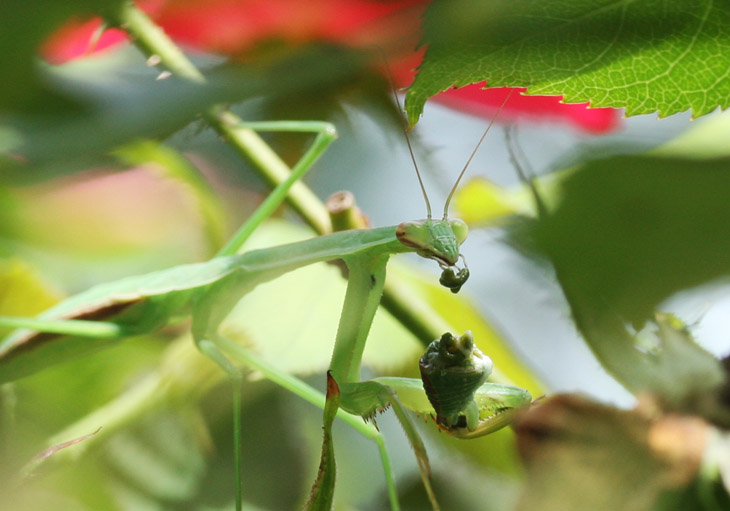
I also managed another vantage, this one obviously from beneath and so getting a little color from the rose blossoms in there. I’ve said it before, but I wish I had mouthfingers. Okay, fine, the technical term is palps, which just goes to show you that scientists are too uptight sometimes, because mouthfingers is way cooler. I just know these would make eating while reading or typing so much easier.
Hey, listen: the internet is full of kittens. Someone has to branch out a bit.
On capital punishment
Capital punishment yet remains a contentious topic, even while we’ve found comfortable positions on many of the moral issues we struggled with for centuries – slavery and racism, women’s rights, legal adulthood, and so on. Perhaps the biggest reason behind this is, there are too many factors that motivate a response, most of them emotional, and most of those have been bred into us for centuries. I’m going to take pains not to portray any stance on the topic, which hopefully shouldn’t be too hard, because I’m undecided on it myself.
First off, we have the justice system in the US, which has the goal of preventing crime, especially further crimes, and to do this, it has three primary facets:
1. Rehabilitate convicted criminals so that they may re-enter society in a functional, acceptable way;
2. Impress any potential criminals with the consequences of their actions;
3. Prevent incorrigible criminals from continuing to commit crimes.
Unfortunately, too many people don’t feel facet 1 is even viable, and in practice, it’s not demonstrating a very good track record, at least in the US. But also in here is the hidden motivation held by a lot of people, which is vindictiveness. This is kind of an emotional version of facet 2, in that it often qualifies the criminal offense beyond legal definitions, sometimes in the manner of who the victim is, sometimes in recognition of how closely we feel the crime. Someone who lives next door to a child who was killed is far more likely to demand a death penalty than someone who lives across the country. And there are, in fact, very good reasons for this. No, let me rephrase that: there are viable explanations for this, but these explanations deserve no value judgment. They are neither good nor bad, they just explain.
Our moral, social structure is something evolved into us over millions of years; natural selection guided us towards reactions that would create the strongest drive towards reproduction – doesn’t seem to connect in any way, does it? But reproduction relies on both survival and a strong tribe, among other things, and so we have a finely developed sense of what’s acceptable behavior within the tribe, and what’s not. Children are naturally our genetic future, breeding (literally) a stronger sense of protection over them, and our ‘neighbors’ – or immediate tribal members – are more likely to both carry similar genes, and cooperate with us in maintaining a strong tribe. So yes, from an evolutionary standpoint, the death of a neighbor child is worse than the death of an adult far away. But of course, this means that criminal acts can become too subjective, relying on the qualification from individuals as to how severe they might be; laws are a recognition of this problem, a fixed value of severity to attempt to rule out subjectivity. This only works if we realize why they are this way, and how variable it can be to rely on our bare emotional reactions.
Our developed sense of fairness comes into play, often with a simple comparison: how come a criminal, who has taken the life/lives of someone else, is allowed to retain their own life? Often it seems a shame we can only kill someone once, and in times past, capital punishment was occasionally carried out in gruesome ways. It is now usually considered bloodlust or barbarism, but we cannot ignore the basic idea that someone who has killed a lot of people can only themselves die once – the scales could not effectively be balanced with a simple execution. At least, if we consider “life” a measuring stick.
A variation of this might be our concept of “future.” We tend to be optimistic about the future, at least from a personal standpoint – we will be making more money, we will travel to that exotic location, we will finish that book we’ve been working on. But when it comes to the worst criminals, we don’t like contemplating the idea that anything beneficial might happen to them.
And then there’s simple fear. To a certain extent, the belief is that a severe criminal cannot be rehabilitated, and continually poses a threat to us as long as they remain present – this is exacerbated by the parole system, where criminals can often be released without even completing the term of their original sentence. This rarely happens in any capital case, the ones where execution would be considered a potential sentence, but this distinction isn’t recognized by enough people. Influencing this is the peculiar genre of horror movies, where the villain continually, almost supernaturally, returns from apparent death to wreak more harm before being dispatched in some spectacular way – this has never happened in real life (even Rasputin’s demise was less dramatic and possibly exaggerated,) but again, this distinction remains vague.
There are a few other factors, such as the belief that life sentences mean a criminal is languishing in prison with free cable TV and no bills or worries, not exactly an accurate idea. Or that the costs of their continued existence, paid for with taxpayer money, would be eradicated with a death sentence – in reality, executions cost many times more than a life sentence, through the exorbitant price of our legal system and the statutory appeals process. This far outweighs the cost of incarceration, which is considerably less expensive than living independently in any community. Too many of the factors upon which many people form their opinions are not accurate or realistic.
The rational argument often comes into play: there is nothing that can be done to reverse the crimes or ever make them ‘acceptable’ in some way – the families will forever feel the loss and anguish. From that viewpoint, the bare prevention of repeated crimes is the sole function, especially among those who recognize that capital punishment has never been shown to be an effective deterrent. In like vein (okay that was inexcusable, I admit it,) comes the argument that killing criminals makes society no better than those it wants to eradicate. Countering this, however, is the argument that it is not the action necessarily, but the reasoning behind it; consider that we celebrate Veterans’ Day here, essentially glorifying death as long as it’s “for our country.” Criminals, however, may act from a sense of selfish entitlement, unbridled rage, or even dysfunctional empathy, while capital punishment is intended to address how unacceptable this is within our society, as well as preventing it from happening again. If someone on the street stabs me in the bicep, this is a hell of a lot less damage and risk to my system than a surgeon removing my appendix; we have to be careful with how we’re measuring or viewing these topics, and why.
All of these, and likely a lot which I haven’t enumerated, crash together into the debate, everyone involved having their own personal recipe of motivations and considerations. Lately I’ve been considering an additional point, one that I haven’t seen mentioned yet I suspect more than a few people feel, at least subconsciously: capital punishment is not just for the criminal, but for the victims and families as well. It may be seen as demonstrating that we do hold the victims in higher regard, something that can often be lost when we see how oddly our justice system treats the matter. The accused are often guaranteed more benefits than the average citizen, from healthcare to attorney’s fees, concerns over humane conditions and even quick, painless deaths, while the families of such victims have to initiate their own legal actions (often at their own expense) just to obtain funeral costs or adequate compensation for the loss of a provider. There are also the rare cases when the accused is considered a victim themselves, suffering from mental illness, functionally incompetent, or (again, not often in capital offenses) a product of social failings. These – again, rare – cases may be taken well out of context, but more importantly, the problems with our legal system have no relation to what we argue for in regards to capital crimes, even when they’re intertwined.
Or, do they? There’s the perspective of a guilty person escaping “justice” (whatever that is,) but also the perspective of an innocent person being punished – this is where the failure of a justice system has a much bigger toll, and one that isn’t considered often enough. Very often, law enforcement personnel find fulfillment of their job duties in convictions, and elected officials will even run on their record of such. Yet convictions are not the key; accurate convictions are, and there is no worthwhile method of measuring these yet; perhaps there never will be. Juries can be biased over whether someone simply looks guilty, and we’re all familiar with the idea that an arrest means, “they got the guy” – before a fair trial has even taken place. This says nothing of the myriad issues with eyewitness testimony and the glossed-over weaknesses of various forms of evidence, ignored because they weaken the case (and thus the record) of prosecuting attorneys. Our legal system is not a game, but you couldn’t tell that from the attitudes and actions of most of those involved, who feel that a case can be won. The human element is a remarkably weak aspect in the whole affair, emotional and improperly focused and unable to wield, or even fathom, complete objectivity. We cannot even determine guilt, the truth of what occurred; all we can do is decide on what we believe occurred.
There is likely no easy answer to all of this, but to even guide us towards viable options, we have to agree on what we’re trying to accomplish, something that has yet to happen. Going back to the three goals of the justice system, we usually rule out rehabilitation as having any potential at all; that’s why capital punishment is even considered. Consequences are still often believed to be of some importance, even though this is most likely a kneejerk reaction; capital punishment does not demonstrate any deterrent effects, especially when those who we find most deserving are often socially dysfunctional anyway (that’s why they can commit such crimes in the first place – we’re usually not talking about the average member of the public and their social mores.) And when it comes to preventing further crimes for the individual, capital punishment and life sentences are equally effective.
But that’s not enough, is it? We want more, and I’m comfortable saying that this is because we have a drive to maintain a strong society; we want to weed out the bad elements, both by direct action and indirect threat (consequences.) We want to define our lives as being protected, mutually cooperative, and precious. There’s nothing wrong with this – we wouldn’t have survived without it, I’m betting. But how do these drives translate into an effective reaction to major crimes? Is it possible that we are driven, in part, towards execution for our own peace of mind rather than because it serves a specific function?
Most especially, is there a balance point between having a working justice system and believing it is performing as usefully as possible? It’s safe to say there is no perfect society on the horizon, no way that all such crimes will be forever eradicated, no matter what. But can we find something that a majority of people will agree is an adequate response to capital crimes? We easily recognize there is a debt, if you will, that can never be repaid. Or, is there? Is a portion of the problem solely in our perspectives?
Someone who loses a loved one over cancer may be motivated towards eradicating cancer, but overall, the loss is largely accepted as being something that just happened. Auto accidents are sometimes viewed much the same way, or sometimes seen as evidence that we are not accepting high enough standards for vehicular safety. But a murder usually becomes personal, and for far more people than the immediate family – this isn’t something that happens, but the actions that someone performed, deliberate and intentional; the more intentional and the more vicious, the stronger the demand for retribution. This is, again, those functions long bred into us for a cooperative society – we want to shape acceptable behavior for the tribe, and we can’t do this for cancer or random events, so these are viewed differently. But of course, beyond a certain point we can’t do this for people either; we just rarely recognize the futility of the emotional drive. Not to be too weird, but consider the woman who murders her husband for the insurance money; chances are, it’s not going to happen again, so the prospect of anyone else being in danger is not really an issue. Does that make it better? Yeah, didn’t think so.
Then there’s this little aspect that I don’t even have a decent name for, and forgive me for using this case example. It takes no effort whatsoever, at least in the US, to find those who have a strong opinion on the OJ Simpson trials, most especially the first; very often, you can find those who are quite sure what the verdict should have been. Curiously, none of the people I’ve ever spoken with about the verdict can enumerate the evidence presented and how it affected their decision – yet they’re perfectly willing to pronounce how the trials should have gone, and the flaws within. It’s not like the functions and purpose of our justice system are unknown or poorly illustrated, nor is it unclear why this is in place. But it’s disturbing just how few people accept this. From the incredibly ignorant practice of ‘trial by media’ to the fatuous argument, “Who else would have done it?”, our species is incredibly incapable of grasping the simple concept of, “Let’s see the evidence before coming to a conclusion.” These are the same people who make up juries. Is it even viable to believe we are capable of deciding fairly who lives and who dies? If and when a mistake is made, what do we decide to do in response to that? Are the same people who feel that wrongful death is punishable by death ready to step forward and strap themselves onto the table to atone for their incorrect verdict?
There are numerous contributions from our culture that affect our judgment as well. The phrase, “an eye for an eye,” is scriptural and extremely old, mixed in with passages about subjugating women and avoiding shellfish, but we can still hear it now, and a lot of decisions are based on a variation of it. Closely related is the idea of the ‘scales of justice,’ and how a punishment must fit the crime; this is nonsense on two levels. The first is, what purpose does this serve, and who stands to benefit? And the second is, we often don’t believe it anyway – employers routinely check into criminal records, and there are even laws requiring convicted child molesters to notify their neighbors, both of which demonstrating quite clearly that we don’t actually believe in either the ‘scales’ or rehabilitation (again, at least as practiced, or abjectly avoided, by the US legal system.) And then we have the peculiar currency of ‘life,’ often considering death the worst thing that can happen – yet when we’re dead, we’re not feeling anything at all, as opposed to any form of ongoing punishment. There are lots of ways to make people regret their actions, none of which will take place after death – and many of which impinge into the realm of barbarism. Once again we get into subjective ideas of what’s appropriate.
What if we ignored all of the aspects of punishment and revenge and deterrence, and instead simply focused on balance from a functional standpoint? There is no way, of course, to bring back someone who was killed, but what about seeing that the person responsible provides a positive contribution? Put them to work on projects that improve the community, or any community. No concerns over the cost of incarceration, no worries about criminals lounging around with free cable TV – and even a wrongful conviction doesn’t seem quite as bad then. This is actually practiced now, but to a very limited extent and, to the best of my knowledge, never with capital offenses. It isn’t exactly rehabilitation, but then again, neither is anything else currently in place for capital crimes, and in this manner there is a greater benefit than nothing at all.
Again, I’m not leading towards a conclusion; the entire point is to illustrate how many factors compete for attention, many of them emotional, some of those poorly applicable to the issue at hand. Like so much of human interaction, there is a broad emphasis on reacting rather than considering goals or functionality, usually without any realization that this is taking place. What we feel should be done is probably not as useful as establishing a goal and determining the most effective way to reach it – and this applies to a hell of a lot more than simply capital punishment, or any aspect of our legal system. But to go out on a limb here, I’m going to say that if we have a strong and immediate answer, it probably wasn’t reached by careful and objective consideration.
More precipitation
Near sunset yesterday the thunderstorms rolled in, with conditions too bright to do any time exposures, and after two hailstorms, the rains came again. It’s only been a week since the last, but with sweltering weather that’s causing the plants to wilt in between, and watching the level in the rain barrel declining drastically, it’s something I pay attention to. However, the day after the last we’d installed a second rain barrel, and they’re both brimming now, so it’s good.
The Girlfriend’s Younger Sprog pointed out the visible structure of one of the hailstones we picked up, and I saved it in the freezer for a quick photo illustration, done today when the temperature had returned to “steamy,” so it was melting rapidly as I got the shots, but it still illustrated the layered nature of the stone, less than a centimeter across at this point.

The first storm deposited ice pellets slightly bigger than candies, but the second one following less than an hour behind dropped misshapen, ugly chunks up to 3 cm across, twisted and gnarled – I’ve never seen anything like it.
After the rain and the sunset, the critters came out to play, notably the treefrogs. The Copes grey treefrogs (Hyla chrysoscelis) were calling enthusiastically, one from the region of the backyard, so of course I had to go out and find it. While it stopped calling as my light approached, it got suckered into a false sense of security when I shut the light off and stood still for a few minutes. I’d suspected it was near the pond, and with a loud creeeeek it revealed itself on the fence immediately adjacent, quite a small specimen.

At higher magnification, the peculiar swollen shape of the toe pads is more visible, but if you look carefully you can see the toes of the farther (right) foreleg are actually propped up on a spiderweb – yes, they’re very long and attenuated. The ubiquitous pine needles can be seen adhering to the wet fence slat behind it, to give an idea of scale – I’d estimate this one to be no more than 4 cm, not much bigger than the gnarly hail.
 More calls were coming from the cattail-bearing ditch alongside the main road nearby, so I naturally checked that out too. There were several in the low branches of a tree right above the ditch, calling exuberantly, though they typically halted as the light struck them, so getting an image of one in mid-croak, as this one is, took a few attempts. It would have been an amusing spectacle, as well: the ground sloped sharply directly under the tree, and as I was trying for a good vantage I would attempt to be higher up the slope, which was extremely slippery. With care and patience I would achieve a stable position, but then I’d raise the camera and shift my balance, often as not abruptly losing my footing and doing that sudden eruption of flailing arms at odd angles in an attempt to maintain balance. This was punctuated by both a headlamp and a focusing light on the camera, which would also thrash around in all directions. It must have looked great…
More calls were coming from the cattail-bearing ditch alongside the main road nearby, so I naturally checked that out too. There were several in the low branches of a tree right above the ditch, calling exuberantly, though they typically halted as the light struck them, so getting an image of one in mid-croak, as this one is, took a few attempts. It would have been an amusing spectacle, as well: the ground sloped sharply directly under the tree, and as I was trying for a good vantage I would attempt to be higher up the slope, which was extremely slippery. With care and patience I would achieve a stable position, but then I’d raise the camera and shift my balance, often as not abruptly losing my footing and doing that sudden eruption of flailing arms at odd angles in an attempt to maintain balance. This was punctuated by both a headlamp and a focusing light on the camera, which would also thrash around in all directions. It must have looked great…
I had thoughtfully brought along the voice recorder, so I did a few recordings of the frogs sounding off, one of which was in a branch directly overhead, maybe a meter from the recorder. To get a real feel for it, boost your volume up a bit – the call should almost make you wince.
My favorite photo remains this one, however, taken before another graceless skid down the incline.

There were other critters out taking advantage of the humidity as well – the cattails in the ditch sported a variety of insects, including more mantids and this lesser meadow katydid nymph (genus Conocephalus.) It’s easy to mistake it for a grasshopper – I did, anyway – mostly because they’re closely related. You’ll see more of this species – kinda – shortly.
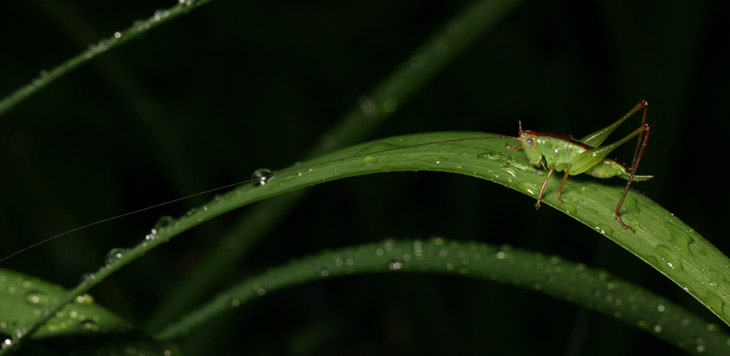
I took another quick trip across to the local pond, spotting several bullfrogs and an untold number of long-jawed orb weavers, spurred into action by the recognition that the rain would produce more flying insect activity as well. It’s also been a very good season for mantids, which can be found everywhere. This minuscule specimen was parading proudly on another patch of cattails, different from the previous.

 Observing the mist rising from the waters of the pond by the light of a half-moon, I went back and got the tripod to do a few time exposures. While I didn’t get anything exciting, and the low-lying steam can only faintly be made out, I did at least capture a firefly in the frame, the streak faintly visible against the sky – one of these days I’ll have to go to a location where they’re very active and do some more long-exposure shots. This one also captured a bit of depth among the background trees – other frames rendered them more of a single-plane silhouette. The green glow from the right is evidence of a mercury street lamp, the kind that are blue to our eyes. Even when I can selectively block the bulb itself from appearing in the frame, it’s hard to eradicate the light spilling from them. I’ll just have to locate a pond without any nearby lights, which could be a challenge.
Observing the mist rising from the waters of the pond by the light of a half-moon, I went back and got the tripod to do a few time exposures. While I didn’t get anything exciting, and the low-lying steam can only faintly be made out, I did at least capture a firefly in the frame, the streak faintly visible against the sky – one of these days I’ll have to go to a location where they’re very active and do some more long-exposure shots. This one also captured a bit of depth among the background trees – other frames rendered them more of a single-plane silhouette. The green glow from the right is evidence of a mercury street lamp, the kind that are blue to our eyes. Even when I can selectively block the bulb itself from appearing in the frame, it’s hard to eradicate the light spilling from them. I’ll just have to locate a pond without any nearby lights, which could be a challenge.
By the way, see the faint smudge just off the leaves in the top right corner? That’s one of the aforementioned spiders, not quite holding still for the five-minute exposure. I actually did another shot of one above the moon (creative positioning,) using the light from the headlamp to illuminate it for a short exposure against the glare of the moon, but it didn’t come out quite the way I wanted, so that remains a project for a little later on.
 At midday today the evidence of the rains still remained in places (I mean, aside from the debris knocked down by the wind and hail,) despite the temperature. Which is good – it will all vanish soon enough. In a little bit I’ll be back with more photos from today, but I’ll inform you ahead of time – all insects, and some may be considered pretty disgusting. I probably don’t have to worry about that anymore, since anyone likely to be affected by that learned their lesson long ago and hasn’t returned.
At midday today the evidence of the rains still remained in places (I mean, aside from the debris knocked down by the wind and hail,) despite the temperature. Which is good – it will all vanish soon enough. In a little bit I’ll be back with more photos from today, but I’ll inform you ahead of time – all insects, and some may be considered pretty disgusting. I probably don’t have to worry about that anymore, since anyone likely to be affected by that learned their lesson long ago and hasn’t returned.
Report from the field, part three
 And so, we conclude our photo tour of Juneau Alaska, courtesy of Jim Kramer, unless he complains that I didn’t feature a particular image that he thought I should (you’ve seen fewer than half of what he sent me – I’m playing the editor game here.) It was a business trip with only three days of photo opportunities, so he accomplished a lot, despite the weather.
And so, we conclude our photo tour of Juneau Alaska, courtesy of Jim Kramer, unless he complains that I didn’t feature a particular image that he thought I should (you’ve seen fewer than half of what he sent me – I’m playing the editor game here.) It was a business trip with only three days of photo opportunities, so he accomplished a lot, despite the weather.
Seen here, a raven (Corvus corax) poses for a portrait. While their territory covers an awful lot of the North American continent, they aren’t to be found in Kansas, where Jim lives, or much at all in NC – I think I’ve seen them at a distance while at Pilot Mountain, but that’s it. They appear to be plentiful in Juneau, however, if the photos I received are any indication. These are pretty good light conditions to tackle subjects of this nature, by the way – the textures and subtle coloration of the feathers would likely have been lost in brighter, higher-contrast light, plus the associations we have with ravens tie in well with somber and moody conditions. A raven in a field of daisies just isn’t going to cut it.

In recognition of Jim’s flat Kansas residence, we shall gaze upon more of Alaska’s ridiculously implausible heights and mountains, such as this view from the Mount Roberts Nature Center looking across Gastineau Channel to Douglas Island and the town of Douglas, just across from Juneau, the barest hint of which appears at bottom. This is from an altitude of about 550 meters (1800 feet,) which is less than halfway up Mount Roberts itself.

I have no idea what peak this is – we shall call it “Squishy.” Don’t look at me that way, just because you’ve forgotten your classic literary references…
 It’s safe to say that if you prefer dry air, open fields, or lots of sunlight, Alaska is not for you. But that’s minimizing the dramatic and rare vistas, and even if you don’t want to live there, it can be a fascinating visit – I admit I’m envious. It’s the kind of remote and impressive landscape that you expect nature photographers to be inhabiting, instead of, you know, college towns in North Carolina…
It’s safe to say that if you prefer dry air, open fields, or lots of sunlight, Alaska is not for you. But that’s minimizing the dramatic and rare vistas, and even if you don’t want to live there, it can be a fascinating visit – I admit I’m envious. It’s the kind of remote and impressive landscape that you expect nature photographers to be inhabiting, instead of, you know, college towns in North Carolina…

Jim’s comment on the part one post now has me identifying this as Gold Creek in Cope Park, probably named appropriately because Juneau was primarily established by the gold rush – there aren’t too many other reasons to form a city in the margin between the channel and the steep mountains, way the hell away from everything else. If Jim found any gold there, he’s been keeping it mum – I’ll wait and see what kind of new photographic equipment he suddenly acquires…
 I am thinking this is looking northwest from Mount Roberts, and that splash of green is the marshy area of the northern part of the channel where the airport sits, but that’s the best I can do until Jim pipes up. I like the framing, especially with the trees reaching for the distant peak, and notice the depth provided by the layering blue haze.
I am thinking this is looking northwest from Mount Roberts, and that splash of green is the marshy area of the northern part of the channel where the airport sits, but that’s the best I can do until Jim pipes up. I like the framing, especially with the trees reaching for the distant peak, and notice the depth provided by the layering blue haze.
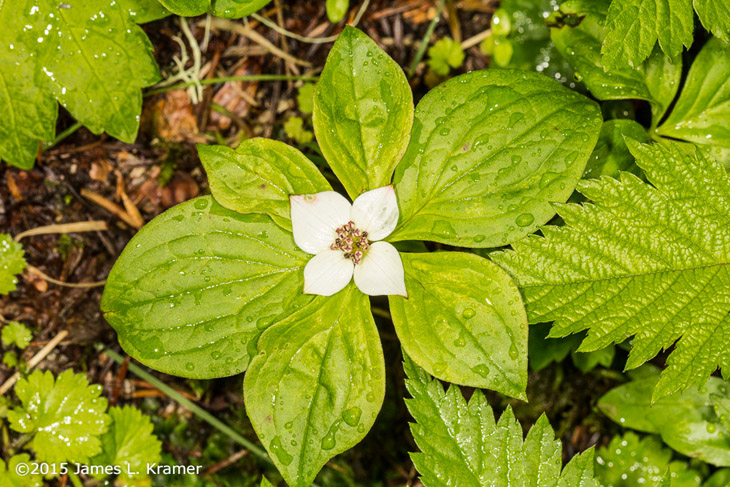
Yeah, I know, now we’re getting into the kind of stuff I normally show here. It’s not exactly intentional, it’s just that there are too few nice scenic landscapes to be found anywhere in this area at all, so I’m forced into doing semi-abstract little tableaux. Lucky for you that the traffic noise never comes through.
 This is Nugget Falls, which empties into Mendenhall Lake not too far from the base of the glacier. Probably not a place to go tubing, no matter how xtreemcooldood you are.
This is Nugget Falls, which empties into Mendenhall Lake not too far from the base of the glacier. Probably not a place to go tubing, no matter how xtreemcooldood you are.

Serious humidity. I doubt anyone there is going out each night to keep the plants watered…

Jim extended the camera up on a really long selfie-stick for this one… no, huh? All right, fine, it was from the plane on the trip back, as Jim says, about 40 minutes into the flight between Juneau and Seattle. Playing with the map, I have a faint suspicion that this is Mt Ratz, but it’s only a guess. Pretty dire-looking peak though, ain’t it?
And I close with a photo that appeals to the humor that both Jim and I possess – since we’re both atheists, a lot of people figure this is right up our alley anyway. The figurehead over the door is great, but don’t ask me why the windows are mismatched, or why the European spelling of “centre” is used. Just for class, is my guess…

Well, I still don’t know
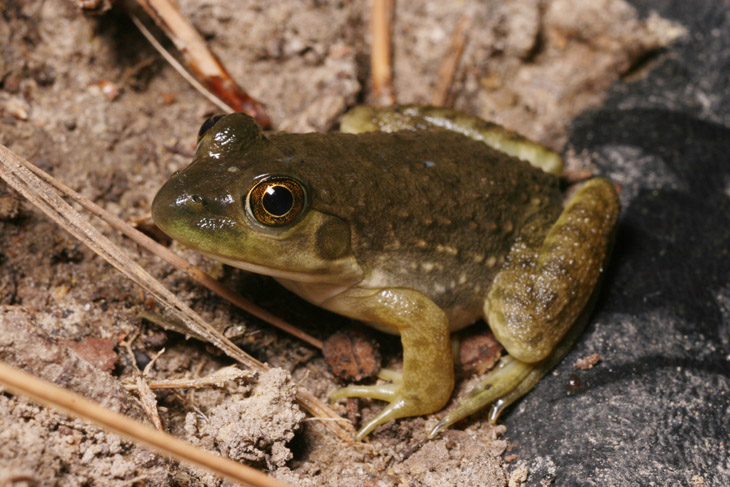
After making the previous post, I went out to water the plants (yes, at 2 am, don’t judge me, I’m not judging you) and was able to creep up on the frog in the pond with the use of the headlamp. The bright light doesn’t register as a danger to them, so even though this one was the wariest I’ve seen in a while, I could do a nice portrait – despite scuffing my foot on the first attempt and sending it hurtling into the water (the frog, not my foot, which remains resolutely attached.)
The problem is, I still don’t know what species this is. In size and body shape it appears to be a green frog (Lithobates clamitans,) but with the lack of a ridge extending back from the eye along the body, called a dorsolateral ridge, it would seem more like a bullfrog (Lithobates catesbeianus) – both of these are common here, and found at the proper pond nearby that serves as the foreground to lightning pics. It’s a small specimen, about 4 cm in body length, so it’s most likely a juvenile, and no source that I’ve found has told me whether the ridge develops later in life.
You might think a nature photographer should know all of this automatically or something, and perhaps this is true for some definition of “should.” But here’s how it works for me: I have shot several hundred different species, from mammals to arthropods to flowers, and the distinctions of many are known mostly to specialists within a given field, such as herpetologists in this case – NC has at least 30 species of frogs and toads alone, probably more counting subspecies. What happens fairly frequently is that I shoot something and find out later what it was – or, also frequently, that I did not capture the necessary detail that would distinguish one species from another, such as belly coloration or the stripe along a leg. But considering how many species I can recognize on sight now, across multiple Kingdoms and Phyla, this method hasn’t been too shabby from an amateur naturalism standpoint.




















































